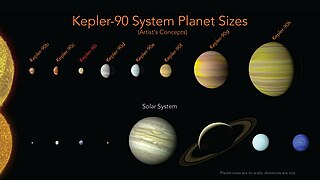Related Research Articles

An exoplanet or extrasolar planet is a planet outside the Solar System. The first possible evidence of an exoplanet was noted in 1917, but was not recognized as such. The first confirmation of detection occurred in 1992. This was followed by the confirmation of a different planet, originally detected in 1988. As of 1 October 2021, there are 4,843 confirmed exoplanets in 3,579 planetary systems, with 797 systems having more than one planet.

Kepler-90, also designated 2MASS J18574403+4918185, is a G-type main sequence star located about 2,840 light-years (870 pc) from Earth in the constellation of Draco. It is notable for possessing a planetary system that has the same number of observed planets as the Solar System.

Kepler-90g is a super-puff exoplanet orbiting the early G-type main sequence star Kepler-90, one of eight planets around this star discovered using NASA's Kepler space telescope. It is located about 2,840 light-years (870 pc) from Earth, in the constellation Draco. The exoplanet was found by using the transit method, in which the dimming effect that a planet causes as it crosses in front of its star is measured. It orbits its parent star about every 210.5 days at a distance of 0.71 astronomical units.
HIP 41378 is a star located 348 light-years away in the constellation of Cancer. The star has an apparent magnitude of 8.92. This F-type main sequence dwarf has a mass of 1.15 M☉ and a radius of 1.25 R☉. It has a surface temperature of about 6,251 K.
HIP 41378 b is an exoplanet orbiting around the F-type star HIP 41378. It has a radius about 2.6 times that of Earth.
HIP 41378 c is an exoplanet orbiting around the F-type star HIP 41378. It has a radius about 2.7 times that of Earth.
HIP 41378 d is an exoplanet orbiting around the F-type star HIP 41378. It has a radius about 3.5 times that of Earth.
HIP 41378 f is an exoplanet orbiting around the F-type star HIP 41378. It has an anomalously large radius for a planet of its size and temperature, therefore the radius may actually be that of an optically thick ring system. It is located within the habitable zone of its parent star.
A super-puff is a type of exoplanet with a mass only a few times larger than Earth’s but with a radius larger than that of Neptune, giving it a very low mean density. They are cooler and less massive than the inflated low-density hot-Jupiters.
HD 121056 is a K-type giant star 209 light-years away in the constellation of Centaurus. Its surface temperature is 4867±49 K. HD 121056’s concentration of heavy elements is similar to the Sun, with a metallicity Fe/H index of 0.020±0.031, although the star is enriched in lighter rock-forming elements like magnesium and aluminum.
L 98-59 is a bright M dwarf star, located in the constellation of Volans, at a distance of 10.623 ± 0.003 parsecs, or 34.648 ± 0.01 light-years, as measured by Gaia.
References
- ↑ Santerne, A.; Malavolta, L.; Kosiarek, M. R.; Dai, F.; Dressing, C. D.; Dumusque, X.; Hara, N. C.; Lopez, T. A.; Mortier, A.; Vanderburg, A.; Adibekyan, V.; Armstrong, D. J.; Barrado, D.; Barros, S. C. C.; Bayliss, D.; Berardo, D.; Boisse, I.; Bonomo, A. S.; Bouchy, F.; Brown, D. J. A.; Buchhave, L. A.; Butler, R. P.; Collier Cameron, A.; Cosentino, R.; Crane, J. D.; Crossfield, I. J. M.; Damasso, M.; Deleuil, M. R.; Delgado Mena, E.; et al. (2019). "An extremely low-density and temperate giant exoplanet". arXiv: 1911.07355 [astro-ph.EP].
- 1 2 3 "HIP 41378 e CONFIRMED PLANET OVERVIEW PAGE". NASA Exoplanet Archive. Retrieved 2016-07-08.


